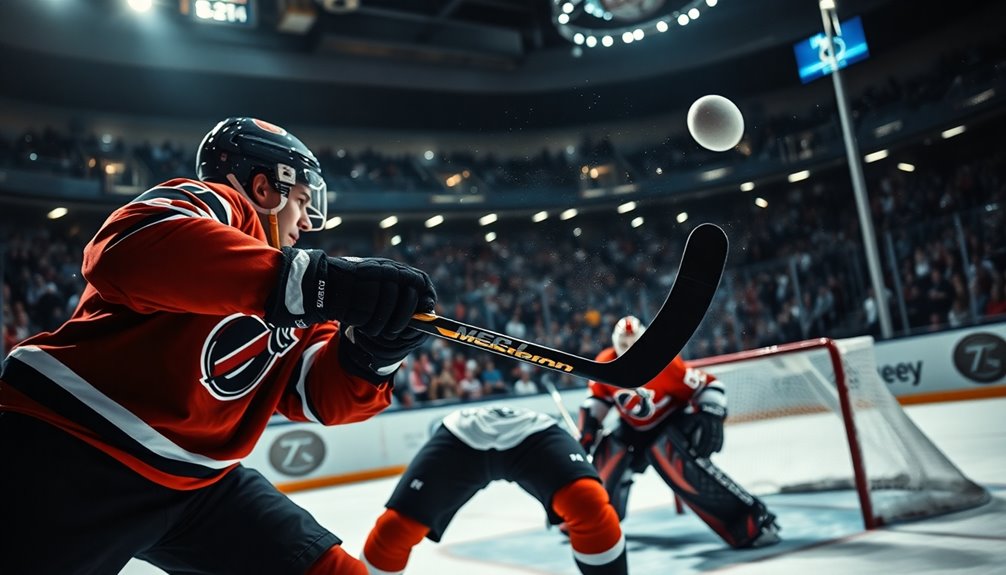
How Hockey Players Earn Points During a Game
January 1, 2025In hockey, you earn points by scoring goals and assisting teammates. Each goal counts as one point and occurs when the puck fully crosses the goal line. You can also rack up points through assists, given to the last two players who touched the puck before the goal. Each assist gives you an additional point, meaning one goal can lead to three total points if both assists are credited. Understanding how these points are earned helps appreciate the game more. There's much more to explore about scoring types and the significance of each point in the grand scheme!
Basics of Hockey Scoring
When you watch a hockey game, understanding how scoring works is essential to following the action. In the NHL, teams earn points primarily by scoring goals, with each goal counting as one point on the scoreboard. A goal is officially recognized when the puck completely crosses the goal line between the posts and under the crossbar.
Players can also earn assists, which are given to up to two teammates who help set up the goal-scoring play. Assists reward collaboration and skill, highlighting the importance of teamwork in hockey. The concept of teamwork is crucial, as it can lead to effective strategies that mirror the importance of stoppage time in soccer, ensuring that every moment counts. This collaboration can also be likened to the high-pressure situations faced by teams battling against relegation threats in soccer.
Goals can be scored during various situations, such as regular play, power plays, or when a team is shorthanded. Regardless of how a goal is scored, all goals contribute equally to a team's total score.
The team with the highest number of goals at the end of the game wins, and this final score determines the points awarded for that match outcome. Additionally, just like in soccer, understanding the offside rule can significantly impact the game dynamics and scoring opportunities.
Understanding these basics of scoring gives you a clearer picture of the game's dynamics, enhancing your experience as a fan. So, keep an eye on those goals and assists to fully appreciate the scoring in hockey!
Understanding Goals in Hockey
When you watch a hockey game, understanding how goals are scored is essential. Each goal you see counts as a point, awarded to the last player who touched the puck, along with potential assists from teammates. Additionally, the strategic importance of set pieces can be seen in both hockey and soccer, as teams capitalize on scoring opportunities during key moments of the game. Effective passing during fast breaks can create scoring opportunities that lead to goals. Different types of goals, from breakaways to empty-net situations, all play a role in shaping the game's outcome. Furthermore, the evolution of sports like soccer, as seen in early forms of soccer, illustrates how various games have contributed to the development of competitive team sports.
Scoring Mechanics Explained
Understanding how goals are scored in hockey is essential for appreciating the game's dynamics. A goal is counted when the puck completely crosses the goal line. The last player to touch the puck before it enters the net earns the goal and one point. Additionally, assists can be awarded to up to two players who helped set up the scoring play.
Here are some key points about scoring mechanics:
- Goal Scorer: The player who puts the puck in the net.
- Primary Assist: The last player who passed the puck to the goal-scorer.
- Secondary Assist: The player who assisted the primary assister.
Goals can be achieved through various methods, such as wrist shots, slap shots, or deflections, showcasing the players' skills.
A maximum of three players can earn points on a single goal, emphasizing the collaborative nature of scoring in hockey. Each player plays a crucial role in creating scoring opportunities, whether by directly scoring or setting up their teammates.
Understanding these mechanics enhances your enjoyment of the game as you witness the teamwork behind each goal.
Types of Goals
Goals in hockey come in various forms, each showcasing a player's skill and strategy. Understanding the different types of goals can help you appreciate how points in hockey work. Players can score during even-strength play, power plays, shorthanded situations, or when the opposing net is empty.
A player scores a goal when the puck completely crosses the goal line, and it's essential that this happens without any rule violations like goaltender interference.
There are several types of goals, such as wrist shots, slap shots, and deflections. Each method reflects a player's versatility in scoring goals. For instance, a wrist shot offers accuracy, while a slap shot generates power.
The last player to touch the puck before it enters the net is credited with the goal, and assists awarded to teammates can enhance their scoring tallies, but we won't explore that just yet.
Additionally, own goals can occur when a player accidentally scores in their own net, leading to a point for the opposing team.
Understanding these types of goals enriches your viewing experience and helps you recognize the strategic depth of the game.
Assists and Contributions
Scoring in hockey isn't just about putting the puck in the net; it's also about teamwork and the contributions players make along the way. Assists play a significant role in this collaborative effort. When a goal is scored, the last two players who touched the puck receive credit for assists, showcasing how essential every player's contribution is.
Here's a quick breakdown of how assists work:
- Primary Assists: The player who makes the last pass to the goal-scorer.
- Secondary Assists: The player who passed to the primary assister.
- No Assists on Own Goals: Only the last player on the scoring team earns credit for these.
While a player earns one point for each goal, they can accumulate multiple points through assists. This means that a player's total points reflect not just their scoring ability but their overall contributions to the team's success.
Scoring a Goal in Detail
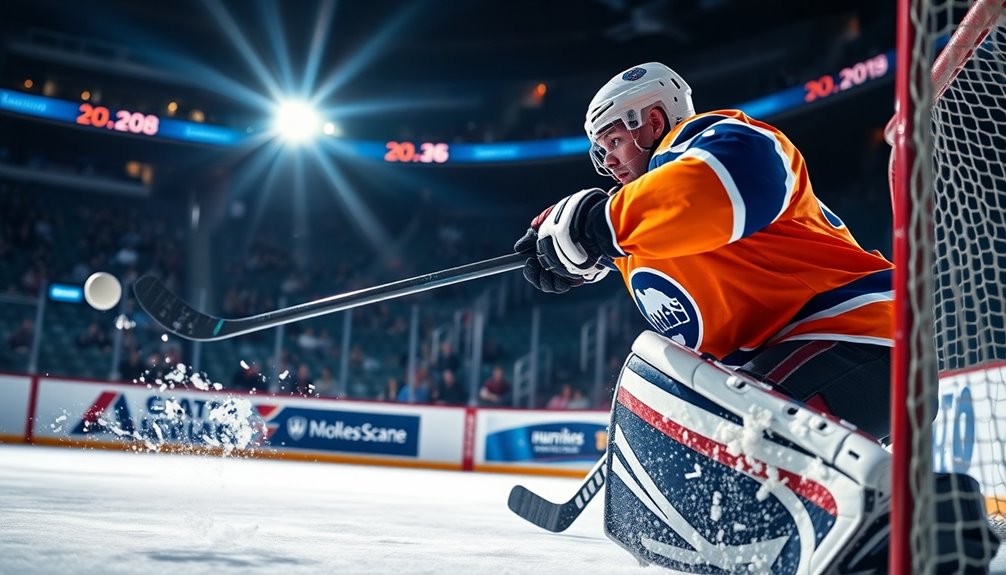
When you score a goal, you're not just putting points on the board; you're also showcasing your skills and understanding of the game. A strong defense can often create counterattacking opportunities that you can exploit to increase your scoring potential. Each goal has its own mechanics and methods, whether it's a wrist shot or a power play opportunity. You'll also want to reflect on how assists and contributions from teammates can amplify your scoring potential. Additionally, understanding key regulations can enhance your ability to capitalize on scoring opportunities. The dynamics of scoring in hockey also share similarities with handball rules in soccer, where positioning and player actions play a crucial role in determining the outcome of scoring chances.
Goal Scoring Mechanics
Understanding how a goal is scored in hockey involves recognizing the precise mechanics that dictate the play. A goal is scored when the puck completely crosses the goal line between the posts and under the crossbar. The last player to touch the puck before it enters the net is credited with the goal.
Here are some key elements to keep in mind:
- Goals can be scored using any body part, except the hands or arms.
- Infractions like high sticking or goalie interference can disallow goals.
- Up to two assists can be awarded, acknowledging the last two players who touched the puck.
When scoring a goal, the player earns points, while points are awarded to those providing assists. Various types of goals exist, including even-strength, power play, and empty net goals.
The ice hockey goal measures 72 inches wide and 48 inches tall, ensuring a standardized playing field. Understanding these mechanics not only enhances your appreciation for the game but also sharpens your skills in scoring a goal effectively.
Every detail matters when it comes to executing and celebrating a successful play!
Assists and Contributions
In hockey, every goal tells a story of teamwork, with assists playing an essential role in that narrative. When a goal is scored, the last two players to touch the puck earn assists, showcasing their crucial contributions to the play.
You'll find that the primary assist is credited to the player who makes the final pass to the goal-scorer. Meanwhile, the secondary assist goes to the player who set up the primary assister.
It's important to note that no assists are awarded for own goals; in such cases, the last player on the scoring team receives full credit. Each goal nets one point, but assists also contribute to a player's overall points total. This reflects not only individual scoring but also the collaboration critical to the team dynamic.
In total, a maximum of three points can be awarded for a single goal: one for the goal-scorer and up to two for the assisting players. This system emphasizes how every player on the ice has a role to play in achieving success, turning each goal into a shared accomplishment.
Types of Goals
Scoring a goal in hockey is an exciting and dynamic process that showcases a player's skill and determination. A goal is officially scored when the puck completely crosses the goal line between the posts and under the crossbar.
Players need to avoid violations, like kicking or throwing the puck, to guarantee the goal counts. Here are some types of goals you might see during a game:
- Even-strength goals, scored when both teams have equal players on the ice.
- Power-play goals, scored while the opposing team is shorthanded.
- Empty-net goals, when the goalie is pulled for an extra attacker.
The last player to touch the puck before it crosses the line gets credit for the goal, while up to two assists can be awarded to those who contributed to the scoring play.
Goals can be scored using any body part except the hands or arms, and players often use various shot types like wrist shots or slap shots.
Keep an eye out for own goals too, where a player accidentally scores in their own net, giving the opposing team an unexpected point.
Types of Goals in Hockey
Hockey features several distinct types of goals that contribute to a team's success on the ice. You'll often see even-strength goals scored when both teams have the same number of players on the ice.
Power-play goals, however, occur when the opposing team is short-handed, giving you a significant opportunity to capitalize on your advantage. On the flip side, shorthanded goals are scored by a team that's down a player, showcasing resilience and skill. Effective ball control can make a significant difference when executing these plays.
Another exciting type of goal is the empty-net goal, which happens when the opposing goaltender is pulled for an extra skater. This creates a chance to score into an unguarded net, often sealing a game. The ability to execute quick transitions during these moments can significantly enhance scoring chances.
Then there are own goals, where a player accidentally scores in their own net, gifting a point to the other team.
Penalty shots present a unique scoring opportunity, allowing you a one-on-one chance against the goaltender after being fouled during a scoring attempt.
Mastering various shooting techniques, like wrist shots and slap shots, enhances your ability to score goals from different positions on the ice. Each type of goal plays an essential role in determining the outcome of the game. Additionally, understanding tactical strategies can significantly improve a player's effectiveness in creating scoring opportunities.
Assists and Their Importance

When you watch a game, you might notice how essential assists are in the scoring process. They not only boost a player's point total but also showcase the teamwork that defines hockey. Understanding the types of assists and their impact on scoring can give you a deeper appreciation for the game. Unity on the soccer field is essential for success, as it emphasizes the importance of collaboration in any team sport. Moreover, commitment and perseverance are crucial in achieving goals, whether on the ice or the field. Additionally, recognizing the value of teamwork and unity can inspire players to set aside personal agendas for the greater good of the team.
Types of Assists
In the fast-paced world of hockey, assists play a crucial role in a team's success and a player's reputation. When you contribute to a goal, you can be credited with an assist, showcasing your essential skills in playmaking and teamwork.
There are two main types of assists:
- Primary assists: Awarded to the last player who directly passes the puck to the goal-scorer.
- Secondary assists: Given to the player who passed to the primary assister, creating a chain of contributions.
- Own goals: No assists are awarded; the last player on the scoring team gets credit without any assists involved.
Accruing a high number of assists reflects a player's ability to create scoring opportunities, contributing considerably to the overall team dynamics.
Remember, both primary and secondary assists count equally with goals in overall scoring statistics. This means that a player's contribution in setting up goals can elevate their point total just as effectively as scoring.
Understanding these types of assists can help you appreciate the complex interplay of teamwork that defines hockey.
Impact on Scoring
A player's contribution to scoring goes beyond just putting the puck in the net; assists are essential in shaping a team's offensive success. In hockey, assists are awarded to up to two players who directly contribute to a goal. The primary assist goes to the last player who passed the puck before the goal-scorer, highlighting the importance of teamwork in scoring.
Your point total includes both goals and assists, showcasing your overall offensive impact and playmaking abilities on the ice. Each goal scored earns you one point, while your assists also count as points, allowing you to notably boost your total through effective passing and collaboration.
Statistically, you can accumulate multiple points in a single game, with a combination of goals and assists demonstrating your versatility and contribution to the team.
Understanding the role of assists in point accumulation emphasizes the collaborative nature of hockey, where one goal can involve several players working together to create scoring opportunities.
Points System Explained
The points system in hockey is vital for tracking player performance and contributions to the team's success. In this system, players earn points primarily through goals and assists. Each goal scores one point, while assists are awarded to the last two players who touched the puck before the goal-scorer. This means an assist is a point, which can greatly boost a player's total.
Here's a quick overview of how the points system works:
- A player can only earn one point for scoring a goal.
- Players can accumulate multiple points in a game from both goals and assists.
- Points are important for individual accolades, like the Art Ross Trophy, awarded to the player with the most points during the NHL regular season.
Tracking these points not only reflects a player's offensive contributions but also highlights teamwork in scoring situations.
The overall points tally throughout the season showcases who's making a notable impact, thereby influencing both individual and team success. Understanding this system helps fans appreciate the intricacies of the game and the efforts of their favorite players.
Goal Violations and Disallowances
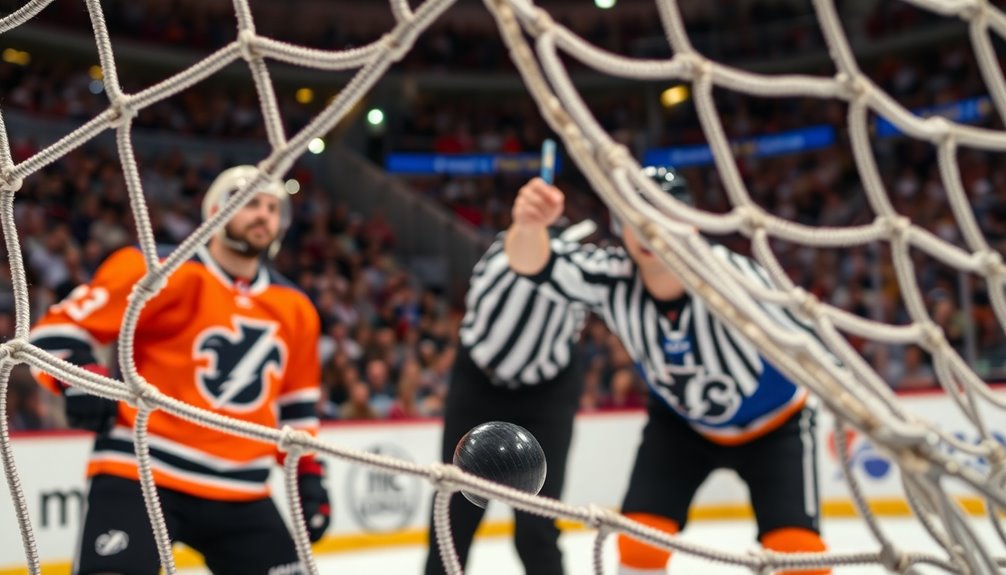
When you're watching a game, it's essential to know why some goals get disallowed.
Violations like high stick infractions and goaltender interference can turn a thrilling moment into disappointment.
Understanding these rules helps you appreciate the game even more.
Reasons for Goal Disallowance
Understanding why goals get disallowed is essential for any hockey fan. Goals can be thrilling, but their validity hinges on strict rules. Here are some common reasons for goal disallowance:
- High Stick: If the puck is struck above the crossbar before it enters the net, the goal won't count.
- Intentional Kicking or Throwing: A goal scored with an intentionally kicked, batted, or thrown puck by an attacking player is also invalidated.
- Interference: If an attacking player interferes with the goaltender during a scoring play, the goal will be disallowed.
Additionally, goals are nullified if the net is displaced or improperly positioned at the time of the score. Offside infractions play a role too—if the attacking player entered the offensive zone before the puck, the goal is ruled out.
Understanding these rules helps you appreciate the complexity of the game and why some goals get chalked off.
Next time you see a disallowed goal, you'll know the specifics behind the call and the importance of following the rules to maintain fair play.
High Stick Infractions
High stick infractions can greatly impact the game, as they often lead to disallowed goals and potential penalties. If a player scores a goal using a high stick—defined as playing the puck above the height of the crossbar—the goal is disallowed. This means that when the puck crosses the goal line after being intentionally redirected by a high stick, the play is halted, resulting in a face-off at the nearest face-off spot.
Not only do these infractions nullify goals, but they can also lead to penalties. If a player commits a high stick infraction, it may give the opposing team a power play opportunity, putting your team at a disadvantage.
To avoid such situations, players are instructed to keep their sticks below the crossbar during gameplay.
In cases where the goal is in question, video review can be utilized to confirm if the high stick was involved in scoring. This technology guarantees accuracy in disallowance calls, allowing officials to make the right decisions in high-pressure situations.
Awareness of these rules can help you play smart and keep your team's scoring opportunities alive.
Goaltender Interference Rules
Goaltender interference is another critical area where goals can be disallowed in hockey. This occurs when an attacking player disrupts the goaltender's ability to make a save. If you're in the crease or impede the goaltender's movement while trying to score a goal, the goal will likely be disallowed.
Here are some key points to remember:
- Contact with the goaltender before the puck crosses the goal line results in a disallowed goal, no matter what.
- The determination of goaltender interference often depends on the referee's judgment, which can lead to disputes.
- Intentional goaltender interference can also lead to penalties for the attacking player.
In essence, if you're trying to score, be mindful of your positioning and actions around the net.
Even if you think you've scored, the referee's judgment could nullify the goal based on your interference with the goaltender. Understanding these rules can help you avoid costly mistakes and increase your chances of getting that goal on the scoreboard.
Impact of Goals on Games
Goals play a pivotal role in hockey, serving as the primary means of scoring and directly impacting the outcome of games. Each goal you see is worth one point, and the team with the most goals at the end of three periods wins. This makes scoring critical for achieving victory and often dictates the game's flow.
When a team scores, it can shift the momentum and morale for both teams. An early goal can energize the scoring team while demoralizing the opponent, creating an intense atmosphere on the ice. High-scoring games tend to attract more fans and media attention, reflecting how much excitement goals can generate.
Furthermore, goals also have significant implications for players' careers. Scoring records can influence player contracts and trades, emphasizing how critical your ability to score is to your team's success and your future in the league.
The impact of goals is felt beyond just the scoreboard; it shapes the narrative around games and player achievements. To summarize, goals aren't just points on a board; they're essential to the essence of hockey itself.
Historical Scoring Records
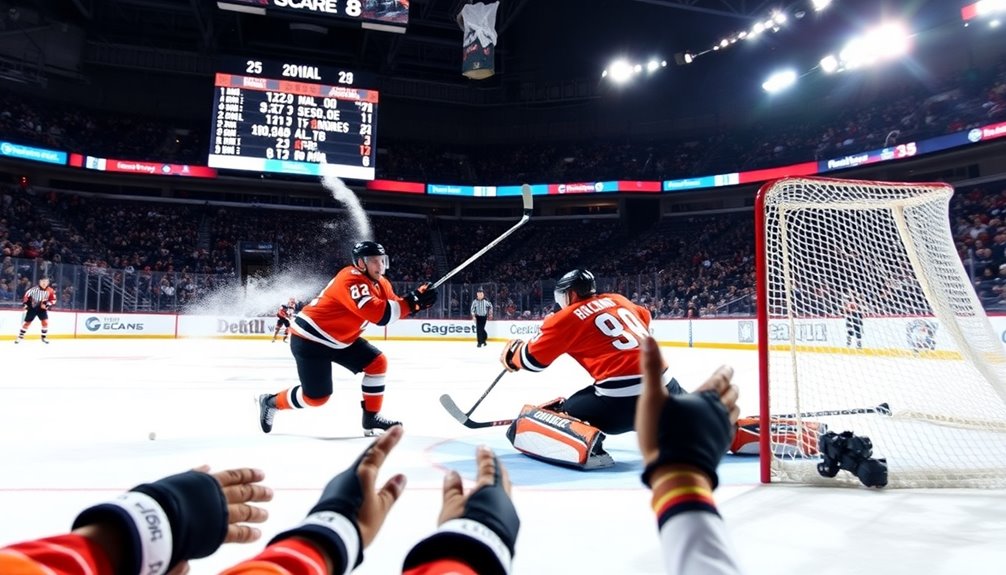
Throughout the history of the NHL, scoring records have become milestones that define the careers of legendary players. The most notable of these is Wayne Gretzky, who holds the record for the most points in NHL history with an astonishing 2,857 points—a combination of 894 goals and 1,963 assists. His dominance in the scoring system has set a bar that seems insurmountable.
Other remarkable players have also left their mark:
- Jaromir Jagr ranks second with 1,921 points, including 766 goals and 1,155 assists.
- Maurice Richard was the first to score 50 goals in a single NHL season, a feat that established a benchmark for future scorers.
- The Art Ross Trophy is awarded annually to the player with the highest points total, emphasizing the importance of scoring in a player's career.
In recent years, the league has seen a decline in overall goals in a season, which affects how fans perceive scoring records.
These historical milestones continue to influence player aspirations and highlight the significance of goal-scoring achievements in the sport.
Scoring Opportunities and Strategies
Hockey players' success often hinges on their ability to capitalize on scoring opportunities and employ effective strategies. You'll find that scoring opportunities can arise from various plays, such as wrist shots, slap shots, and deflections. Each goal you score earns you one point, so it's essential to maximize your chances during even-strength situations, power plays, or even shorthanded plays.
Breakaway situations are especially important; when you face the goaltender alone, you have a prime scoring opportunity that often leads to high-quality chances. Additionally, keep an eye out for empty-net situations where the opposing goaltender is pulled for an extra skater. This scenario greatly increases the likelihood of scoring a goal.
While focusing on your offensive strategies, remember that assists play a significant role in the overall objective. Up to two players can be credited with assists, emphasizing the importance of teamwork and passing.
The Role of Assists
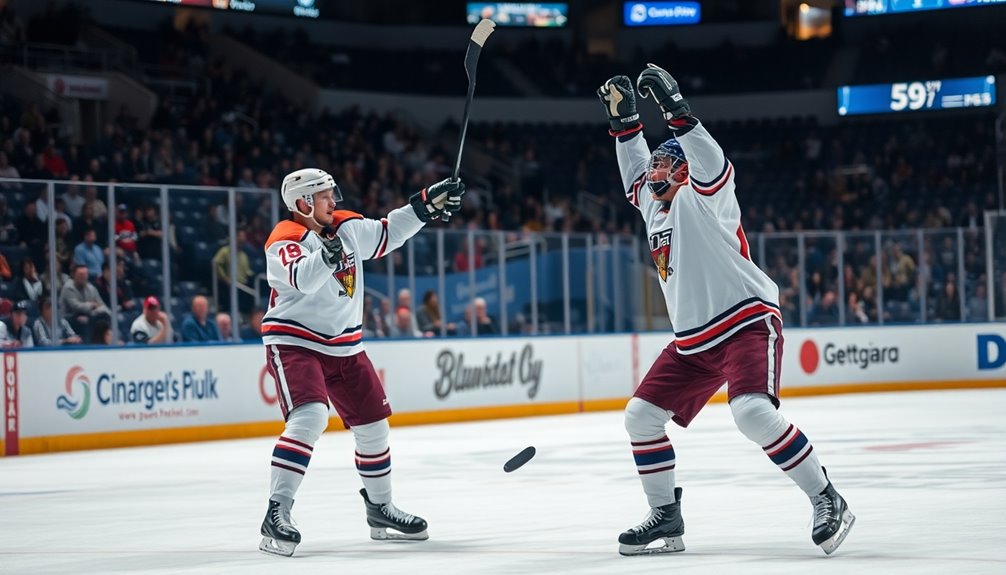
Scoring isn't just about putting the puck in the net; assists play an essential role in the overall success of a team. Assists highlight teamwork and can greatly impact a player's point total. When a goal is scored, the last two players who touched the puck are credited with assists, emphasizing their vital contributions.
Here are some key points about assists:
- Primary Assists: Awarded to the player making the last pass to the goal-scorer.
- Secondary Assists: Given to the player who passed to the primary assister.
- Points System: Each assist earns one point, allowing a single goal to contribute up to three points total.
Assists showcase players' abilities to create scoring opportunities and enhance their team's performance.
As a player, understanding your role in assists can elevate your game and scoring potential. Remember, no assists are credited on own goals; only the last player on the scoring team gets the recognition.
Player Statistics Overview
What metrics really matter when evaluating a player's performance? In hockey, points are scored through goals and assists, making these statistics essential for judging a player's offensive contributions. Each goal counts as one point, and a player can receive up to two assists per goal, which means player statistics reflect a combination of these elements.
Your total points, the sum of your goals and assists, offer a clear picture of your effectiveness on the ice. In the National Hockey League, achieving high point totals can lead to individual accolades like the Art Ross Trophy, awarded to the player with the most points in a season.
While goals often steal the spotlight in discussions about player value, assists are equally important in showcasing a player's playmaking abilities.
For context, consider the legendary Wayne Gretzky, who holds the record for the most points in NHL history, with an astounding 2,857 points throughout his career. This illustrates how critical points are in evaluating not just individual players, but their impact on the game as a whole.
Understanding these player statistics helps you appreciate the nuances of performance in hockey.
Goal Celebration Traditions

After a player puts points on the board, the excitement doesn't stop with the goal itself; it extends into the celebration.
Goal celebrations are a vibrant tradition in hockey, showcasing the joy and camaraderie among players. When your team scores, you'll often see hockey players raise their sticks, jump into the air, or engage in enthusiastic group hugs, all adding to the electrifying atmosphere.
Some key aspects of goal celebrations include:
- Unique personal styles: Players often incorporate signature moves, like the "Selke" or "Gordie Howe" celebration.
- Goal horns and songs: Many teams, such as the Nashville Predators, have specific songs that blast through the arena after a goal, creating an unforgettable experience.
- Energizing the crowd: These celebrations not only boost player morale but also engage fans, making them feel like an essential part of the game.
Points and Individual Accolades
In the fast-paced world of hockey, accumulating points is essential for players aiming to leave a lasting mark on the sport. Points, earned through goals and assists, not only showcase your offensive contributions but also help you stand out among your peers.
Individual accolades, such as the prestigious Art Ross Trophy, are awarded to the player with the highest point total each season, highlighting the importance of scoring and playmaking skills.
Reaching significant milestones, like 1,000 career points, can elevate your status within the league and set a benchmark for future players. Historical records, including Wayne Gretzky's astounding 2,857 all-time points, serve as inspiration for aspiring athletes.
You'll find that points are vital not just for recognition; they also play a pivotal role in contract negotiations and trades. Higher point totals often translate into greater market value, making your performance on the ice a key factor in your career trajectory.
Ultimately, the pursuit of points not only fuels your personal ambition but also establishes your legacy in the sport, paving the way for future opportunities and accolades.
How Scoring Affects Team Dynamics
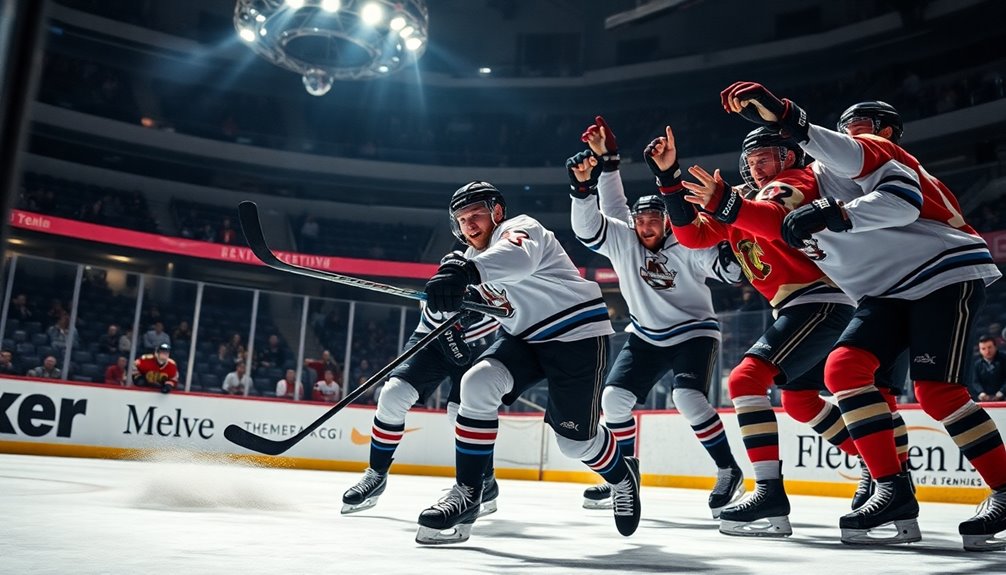
Accumulating points not only benefits individual players but also greatly influences team dynamics on the ice. When scoring occurs, it can energize your team, boosting morale and shifting momentum in your favor. This enhanced energy often leads to improved performance in subsequent plays, making scoring essential for team success.
Additionally, teams that consistently find the back of the net tend to dominate possession and control the game's pace. This offensive success allows you to dictate defensive strategies, forcing opponents to adapt. High-scoring games are also more exciting for fans, drawing in larger crowds and media attention, which can enhance the team's visibility and impact player contracts.
Consider these aspects of scoring and team dynamics:
- A goal can spark a rallying effect, uniting players in pursuit of more points.
- Coaches adjust strategies in real-time based on scoring patterns, affecting overall game outcomes.
- Scoring milestones create a competitive atmosphere, pushing players to achieve both personal and collective goals.
Ultimately, scoring shapes not just the game, but the very fabric of team dynamics, motivating players and influencing strategies throughout the match.
Conclusion
In the grand game of hockey, each point scored is like a note in a symphony, creating harmony among players and fans alike. When you witness a goal, it's not just a score; it's a spark that ignites teamwork and passion. Just as a composer values each note, you'll appreciate how assists and goals weave together the fabric of the game. So, embrace the excitement, and remember, every point is a step toward victory in this exhilarating dance on ice.


